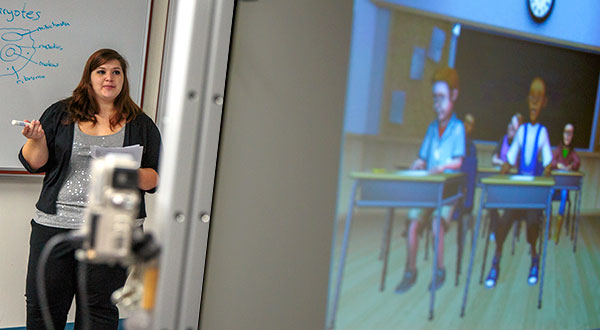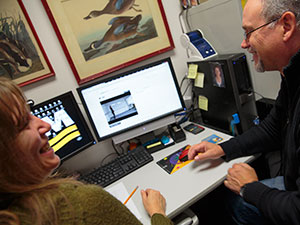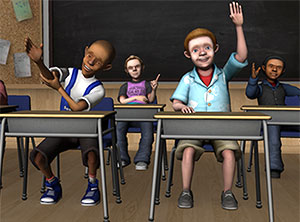
“No students were harmed in the making of this teacher.”
If the TeachLive program had a motto, that might be it.
TeachLive is an interactive computer- and human-facilitated simulation of a classroom with five avatars who behave as typical middle- or high-school students. The goal is to help potential teachers learn how to improve their skills, and to better prepare them to teach real students in a real classroom.

Basically, says Craig Berg, professor of education at the University of Wisconsin-Milwaukee, the program lets students learning to become teachers try out their lesson plans in a controlled environment – with a limited number of simulated students, who respond to a teacher’s questions, ask the teacher questions, make comments to the teacher and fellow students, and also display various levels of misbehaving.
The program isn’t meant to replace clinical experiences in real classrooms, says Berg, but to help students develop basic skills and techniques early in their education, in a controlled, less chaotic, less complex environment.
Avatars act up

One key element of TeachLive is the ability to program the virtual students to act up in various ways and at various levels. Dealing with “Sean,” one of the avatars who was displaying an increasing level of misbehavior in their first online session, was pretty challenging, the students agreed.
“Many novices are overwhelmed when they first begin teaching in a real classroom of 24-30-45 students,” says Berg. “While they may have good intentions and a suitable lesson plan, they can be quickly derailed by student misbehaviors.”
The TeachLive classroom provides a realistic-looking classroom and five virtual students who can act out and challenge the teacher’s authority in a variety of ways.
Since discipline issues are what teachers struggle with the most, says Berg, developing proactive and reactive classroom management strategies and skills is a crucial aspect of teachers’ success. That’s especially true during the first few years of teaching, when many new teachers drop out of the profession due to frustration and lack of success, he adds.
The importance of feedback
The simulation doesn’t just focus on student misbehaviors, Berg says, but also helps students improve their teaching even if no one in the class misbehaves.
Novice teachers sometimes plan lessons without trying them out on students, he explains, so they don’t get any interaction or feedback.
“They don’t know if students are developing an understanding of the material or whether they’re completely befuddled.”
“The teacher is mostly talking and proceeding, while students are passively and sometimes politely sitting in their seats. The teacher is forging ahead as planned, oblivious to what we know about effective teaching practices – much like a college lecture.”
Sometimes a single student question – like “Why do we have to know this stuff? — quickly derails the teacher.
“It is priceless to watch teachers’ expressions when they have developed a whole lesson but haven’t thought about why their students should learn that specific content, or when a student asks a question that causes the teacher to think, and realize that their own understanding of the content is not what they thought it was, nor what it should be to teach it effectively.”
A University of Central Florida team (including Lisa Dieker, a former faculty member in UWM’s School of Education) developed the TeachLive program, and Berg and UWM are among the 22 university partners involved in testing it.
“I was worried before I tried it,” says Robin McGuigan, a junior in education, after her second session with the TeachLive program. “It’s a little like a video game, but the object is to get your students engaged in the lesson.”
“The first time around, it was kind of creepy,” says Trevor Derksen, also a junior in education, “but now I’m finding it very useful.”
Berg says because the avatars are speaking and talking in real human voices and interacting with the teacher much like real students might, it causes a bit of dissonance, and students often wonder how this simulation works.
In UWM’s TeachLive lab, the aspiring teachers are videotaped as they present their lessons. Berg then goes over the videotape with the students and offers feedback.
Defining and refining skills
The beauty of the virtual classroom, he says, is that students can go back in and work on lessons, or redo and improve their teaching – practicing until they learn the skills they need.
“Teaching is an extremely complex task, especially if the lesson is an effective one and all students are engaged to the max,” says Berg. “Research tells us very clearly that to have the most impact on learning, we need to think of a class of students as 30 individual learners, finding out what they know or think and getting them all connected and deeply engaged in the lesson.
“To create this type of learning environment is a very complex task, so we place future teachers in a controlled setting – TeachLive – and begin with five students, with some of the confounding factors removed, lessening the difficulty.
“Then we can increase the challenge as they develop and refine their teaching skills and elevate their level of confidence,” he says.
It is rare to see anyone teach at even a mediocre level when they first stand in front of a real classroom or the TeachLive simulator, says Berg. “That reinforces the need for highly effective teacher preparation programs like MACSTEP [Milwaukee Area Collaborative Science and Mathematics Teacher Education Program], which use research-based strategies for developing teachers, and the use of powerful tools like TeachLive to help.”







